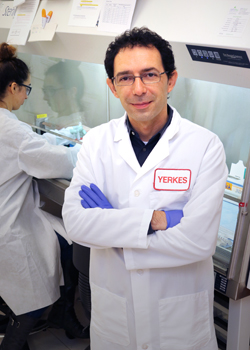 Dr. Mirko PaiardiniMost animal and test-tube models for eliminating latent reservoirs of HIV—the major impediment to an HIV cure—suggest that a pharmacologic approach combining antiretroviral therapy (ART) and inducers of the latent virus alone will not be sufficient to completely eradicate HIV. An infected person’s immune system must also be enticed to play an active role in the effort to eliminate the T cells harboring dormant virus.
Dr. Mirko PaiardiniMost animal and test-tube models for eliminating latent reservoirs of HIV—the major impediment to an HIV cure—suggest that a pharmacologic approach combining antiretroviral therapy (ART) and inducers of the latent virus alone will not be sufficient to completely eradicate HIV. An infected person’s immune system must also be enticed to play an active role in the effort to eliminate the T cells harboring dormant virus.
Writing in the December issue of the Journal of Clinical Investigation, amfAR grantee Dr. Mirko Paiardini from Emory University, along with amfAR-funded scientists Drs. Remi Fromentin, Ann Chahroudi, Christian Apetrei, Nicolas Chomont, Guido Silvestri, and others from Emory University, University of Montreal, University of Pittsburgh, Case Western Reserve, and the Frederick National Laboratory for Cancer Research, report on findings in an exciting new monkey model that may help accomplish this goal.
The researchers sought to quench the HIV-related immune inflammation that continues despite the reduction of HIV levels to undetectable by ART. Such inflammation not only leads to accelerated kidney, heart, and bone disease, but also appears to help maintain the viral reservoirs that persist even after long-term ART. The team postulated that defects in gut immunity found in people living with HIV that cause the release of intestinal microbes into the blood, and perhaps other associated factors, were a major impetus for perpetuating this inflammation, and were therefore a promising target for new treatments.
The scientists used a modified version of a natural immune hormone, IL-21, which is currently undergoing clinical trials to treat advanced cancers. IL-21 is able to restore the number and function of a specialized type of CD4+ helper T cell in the gut, the Th17 cell. HIV infection causes loss of these cells, which hampers gut immunity. In the study, 16 rhesus macaques were infected with SIV, the simian equivalent of HIV. Two months later, all animals were started on a potent five-drug ART regimen. Half of these animals were also given two cycles of six weekly doses of IL-21, injected under the skin. Four additional weekly doses were administered after ART was stopped.
Paiardini and colleagues found that not only were Th17 cells restored and the markers of immune activation decreased in the blood and intestines in the animals receiving IL-21, but the levels of circulating SIV and latent virus were also lower compared with the control animals. These effects were maintained for the entire eight months the animals were observed off ART.
Although the exact mechanisms behind these IL-21 effects remain to be documented, these promising monkey results suggest an important role for IL-21 in clinical trials of HIV eradication.